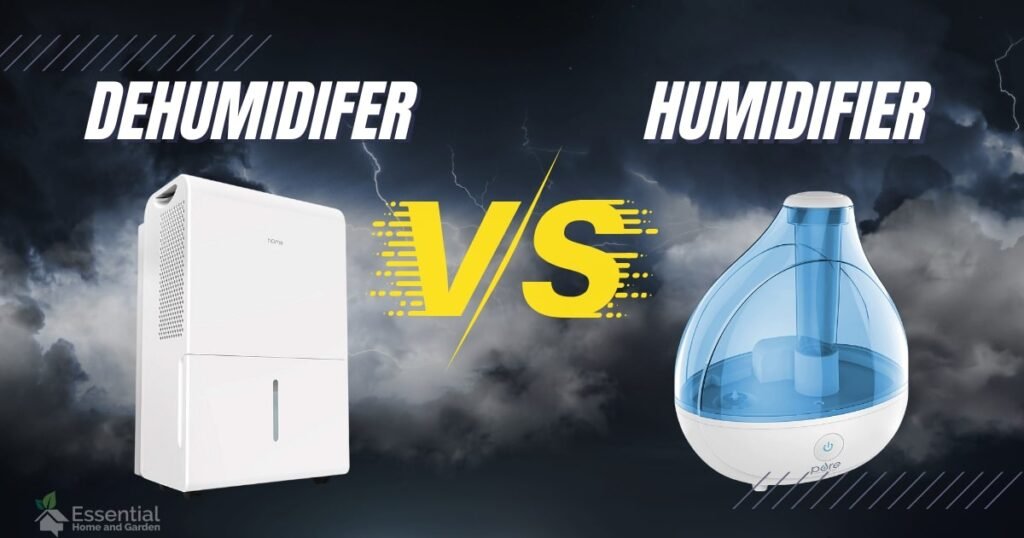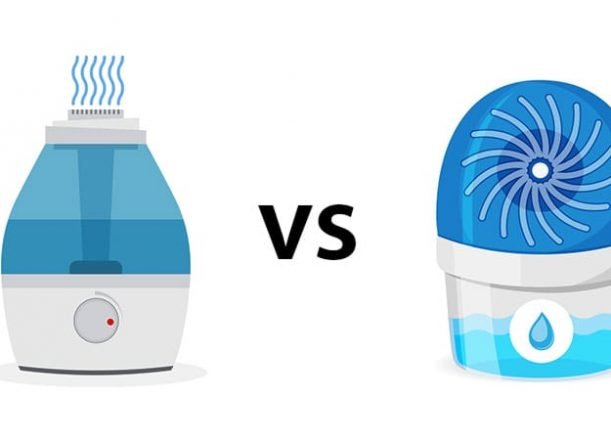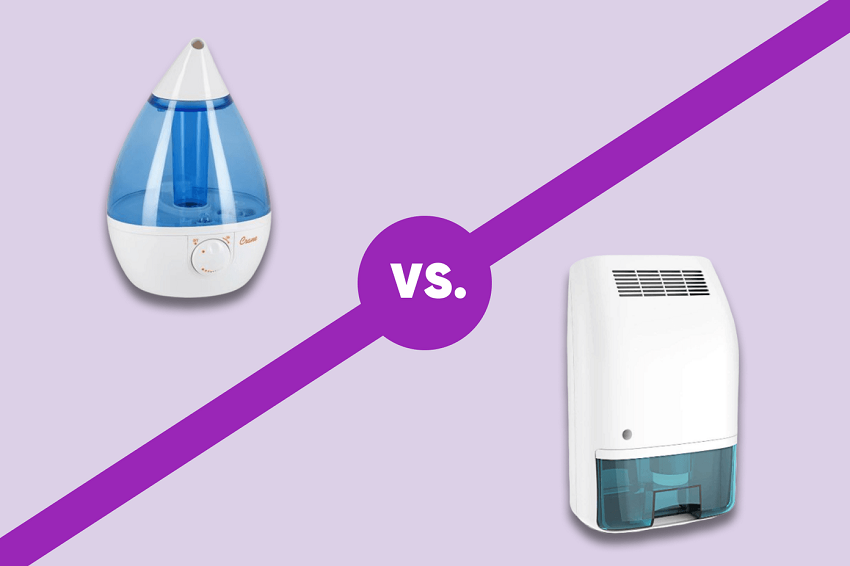
Confused about whether you need a humidifier or a dehumidifier? Don’t worry, we’ve got you covered! In this article, we’ll break down the key differences between these two handy devices, so you can make an informed decision. Whether you need to add moisture to the air or remove excess humidity, we’ll guide you through the ins and outs of humidifiers and dehumidifiers. Say goodbye to confusion and hello to a comfortable home environment!
Overview
Definition of Humidifier
A humidifier is a device that increases the moisture or humidity levels in the air. It works by releasing water vapor or steam into the surrounding environment, which helps to combat dryness and improve the overall air quality. Humidifiers are particularly useful in dry climates or during the winter months when indoor heating systems tend to dry out the air.
Definition of Dehumidifier
On the other hand, a dehumidifier is a device that reduces the moisture or humidity levels in the air. It works by extracting excess moisture from the surrounding environment, helping to combat excessive humidity and prevent issues such as mold growth, musty odors, and dampness. Dehumidifiers are commonly used in humid climates or areas with poor ventilation.
Purpose of Humidifier
The purpose of a humidifier is to increase the humidity levels in a room or space. When the air is too dry, it can lead to various discomforts such as dry skin, irritated eyes, and respiratory problems. By adding moisture to the air, a humidifier helps to alleviate these symptoms and create a more comfortable living environment. It is especially beneficial for individuals who suffer from respiratory conditions or allergies.
Purpose of Dehumidifier
The purpose of a dehumidifier is to decrease the humidity levels in a room or space. Excess humidity can lead to a number of issues, including the growth of mold and mildew, musty odors, and damage to furniture or other belongings. By removing excess moisture from the air, a dehumidifier helps to prevent these problems and create a healthier, more pleasant living environment. It is especially beneficial for areas that are prone to high humidity, such as basements or bathrooms.
Functionality
Humidifier Function
Humidifiers function by adding moisture to the air. There are different types of humidifiers available, including evaporative, ultrasonic, and steam humidifiers. Evaporative humidifiers work by blowing air over a wet wick or filter, causing the water to evaporate and increase the humidity. Ultrasonic humidifiers use vibrations to produce a fine mist of water droplets, while steam humidifiers generate steam by heating water.
Dehumidifier Function
Dehumidifiers function by removing moisture from the air. They typically contain a fan, a refrigeration system, and a collection tank. The fan draws in humid air, which then passes over the refrigeration system. As the air cools, moisture condenses into water droplets that are collected in the tank, and the cooled air is reheated and released back into the room. Some dehumidifiers also utilize desiccants or absorbent materials to extract moisture from the air.
Humidifier Mechanism
Humidifiers have various mechanisms depending on their type. Evaporative humidifiers use a fan to blow air over a moist wick or filter, which absorbs the water and releases it into the air as humidity. Ultrasonic humidifiers use a small metal diaphragm that vibrates at ultrasonic frequencies, breaking water into tiny droplets that are then dispersed as a fine mist. Steam humidifiers heat water to produce steam, which is released into the air.
Dehumidifier Mechanism
Dehumidifiers work by using refrigeration or absorption methods to remove moisture from the air. Refrigeration dehumidifiers use a fan to draw in humid air, which then passes through coils containing a refrigerant. As the air cools, moisture condenses into water droplets that are collected in a tank, while the cooled air is reheated and released back into the room. Absorption dehumidifiers use desiccants or absorbents to attract and remove moisture from the air.
Humidifier Operation
To operate a humidifier, you typically need to fill its water tank, adjust the desired humidity level, and turn it on. The humidifier will then release moisture into the air until the desired humidity level is reached. Some humidifiers have additional features, such as adjustable mist output, built-in timers, or automatic shut-off functions. It is important to follow the manufacturer’s instructions and maintain regular cleaning to ensure optimal performance.
Dehumidifier Operation
To operate a dehumidifier, you need to plug it into a power source, adjust the desired humidity level, and turn it on. The dehumidifier will then start removing moisture from the air as it operates. Depending on the model, you may need to empty the collection tank when it becomes full, or some dehumidifiers have a continuous drain option to allow for continuous operation without manual intervention. Regular cleaning and maintenance are also recommended to ensure efficient operation.

This image is property of rosenberghvac.com.
Benefits
Humidifier Benefits
Using a humidifier offers several benefits. Firstly, it helps to alleviate the discomfort caused by dry air, such as dry skin, chapped lips, and dry nasal passages. It can also provide relief from respiratory conditions like asthma or allergies by moisturizing the airways. Furthermore, a humidifier can help protect wooden furniture or instruments that are sensitive to dry conditions. Additionally, maintaining adequate humidity levels can reduce the transmission of airborne viruses, as they thrive in dry environments.
Dehumidifier Benefits
The benefits of using a dehumidifier include reducing excessive moisture in the air, which in turn helps to prevent mold and mildew growth. By controlling humidity levels, dehumidifiers can also improve indoor air quality, reducing the risk of respiratory issues and allergies. In addition, removing excess moisture helps to protect furniture, clothing, and other belongings from damage caused by dampness. Dehumidifiers can also be beneficial for people with certain health conditions, such as asthma or arthritis, as high humidity can exacerbate symptoms.
Effects on Health
Humidifier Effects
Humidifiers have positive effects on health when used properly. They can alleviate dry skin, relieve nasal congestion, and reduce symptoms of allergies or asthma by moisturizing the air. However, excessive use or improper maintenance of humidifiers can have negative health effects. Excess humidity can promote the growth of mold, bacteria, or dust mites, which can trigger respiratory issues or worsen existing conditions. It is important to maintain proper humidity levels and clean humidifiers regularly to avoid these potential risks.
Dehumidifier Effects
Dehumidifiers have positive effects on health by reducing excessive humidity and preventing the growth of mold, which can cause respiratory issues and allergies. By controlling humidity levels, dehumidifiers create a healthier indoor environment and help minimize the risk of mold-related health problems. However, if a dehumidifier is not properly maintained or if humidity levels are excessively low, it can lead to dryness, irritation, or respiratory discomfort. It is crucial to strike the right balance and ensure the dehumidifier is used appropriately.

This image is property of www.essentialhomeandgarden.com.
Suitable Environments
Humidifier Usage
Humidifiers are suitable for various environments, particularly those with dry climates or during the winter months when indoor heating systems tend to dry out the air. They are commonly used in bedrooms, living rooms, and offices to create a more comfortable and healthy atmosphere. Humidifiers can also be beneficial in areas with low humidity levels, such as arid regions or spaces with central air conditioning that dehumidifies the air excessively.
Dehumidifier Usage
Dehumidifiers are suitable for environments with high humidity levels or poor ventilation. They are often used in basements, bathrooms, laundry rooms, or other areas prone to moisture problems. In humid climates, dehumidifiers can help to control excessive humidity and prevent the growth of mold or mildew. They are also useful in spaces that have experienced water damage or flooding, as they help to dry out the area efficiently and minimize potential damage.
When to Use a Humidifier
You should consider using a humidifier when the air humidity is too low, usually below 30-40%. This is especially important during the winter months when indoor heating systems can significantly reduce humidity levels. Additionally, if you experience dry skin, chapped lips, sinus congestion, or allergy symptoms, a humidifier can provide relief by adding moisture to the air. It is essential to monitor humidity levels and adjust the humidifier’s settings accordingly for optimal comfort.
When to Use a Dehumidifier
A dehumidifier should be used when the air humidity is too high, typically above 50-60%. High humidity levels can cause condensation, promote mold growth, and create an uncomfortable and potentially unhealthy living environment. If you notice musty odors, dampness, or signs of mold in your home, using a dehumidifier can help to alleviate these issues. It is advisable to monitor humidity levels regularly and use a dehumidifier as needed to maintain a suitable and pleasant indoor environment.
Common Features
Humidifier Features
Humidifiers come with various features to enhance functionality and convenience. Some common features include adjustable humidity settings, variable mist output, built-in timers, and automatic shut-off functions. Certain models also offer additional features such as aromatherapy capabilities, built-in hygrometers to monitor humidity levels, or ultraviolet (UV) light technology to inhibit the growth of bacteria or mold in the water tank. Each feature provides unique benefits and allows users to customize their humidifying experience.
Dehumidifier Features
Dehumidifiers also come with a range of features to cater to diverse needs. Most models offer adjustable humidity settings, allowing users to set the desired humidity level. Automatic defrost functions are common in dehumidifiers to prevent the coils from freezing in colder temperatures. Some dehumidifiers have built-in hygrometers to monitor humidity levels, while others offer digital displays for easy operation. Additional features can include continuous draining options, air purifying functions, or air filtration systems to further improve indoor air quality.
This image is property of fv9-3.failiem.lv.
Maintenance
Humidifier Maintenance
Regular maintenance of a humidifier is crucial to ensure optimal performance and prevent the growth of bacteria or mold. It is essential to follow the manufacturer’s instructions for cleaning and maintenance. Generally, humidifiers should be cleaned at least once a week, and the water tank should be emptied, rinsed, and dried thoroughly. Replace any filters or wicks as recommended by the manufacturer. Regularly inspect for mineral build-up, and descale the humidifier if necessary. Proper maintenance extends the lifespan of the humidifier and ensures clean and healthy moisture distribution.
Dehumidifier Maintenance
Proper maintenance of a dehumidifier is necessary to maintain its efficiency and functionality. Regular cleaning of the collection tank and air filters is essential to prevent the buildup of mold, bacteria, or dust. Follow the manufacturer’s instructions for cleaning and filter replacement. Check and clean the coils or desiccant materials, depending on the dehumidifier type. Ensure the unit is placed on a level surface and free from obstruction. It is important to perform preventive maintenance regularly and keep the dehumidifier in good working condition.
Energy Consumption
Humidifier Energy Usage
The energy consumption of a humidifier varies depending on the type and size of the unit, as well as the settings and duration of operation. Generally, ultrasonic humidifiers are more energy-efficient compared to steam or evaporative humidifiers. It is advisable to choose an energy-efficient model with adjustable mist output and automatic shut-off functions to conserve energy. Using a humidifier for longer periods or at higher mist levels may consume more energy. However, the overall energy usage of humidifiers is relatively low compared to many other household appliances.
Dehumidifier Energy Usage
The energy consumption of a dehumidifier also depends on various factors, such as the size and capacity of the unit, as well as the humidity levels and the area being dehumidified. Energy-efficient dehumidifiers with higher Energy Star ratings typically consume less energy. Dehumidifiers with additional features like built-in humidistats or timers can optimize energy usage by running only when needed. It is important to choose the right-sized dehumidifier for the area to be dehumidified and set the desired humidity level appropriately to minimize energy consumption.

This image is property of trustyjoe.com.
Choosing the Right Device
Factors to Consider
When choosing between a humidifier and a dehumidifier, several factors should be considered. Firstly, assess the humidity levels in your living environment to determine whether you require more moisture or need to remove excess moisture. Consider the size of the area you want to humidify or dehumidify and choose a device with an appropriate capacity. Consider the noise levels produced by the device, especially if it will be used in a bedroom or office. Energy efficiency, ease of use, and maintenance requirements are additional factors to consider before making a decision.
Humidifier Selection
Selecting the right humidifier involves considering the type of humidifier that suits your needs, such as evaporative, ultrasonic, or steam humidifiers. Evaluate the coverage area and make sure the humidifier is appropriate for the room size. Choose a model with adjustable humidity settings and mist output to customize the humidity levels. Consider additional features, such as built-in timers or automatic shut-off functions, based on your preferences. It is advisable to read reviews, compare models, and select a humidifier from a reputable brand that meets your specific requirements.
Dehumidifier Selection
Choosing the right dehumidifier involves assessing the capacity and coverage area needed for efficient dehumidification. Consider the humidity levels in your environment to determine the appropriate moisture removal capability required. Look for a dehumidifier with adjustable humidity settings and an auto-defrost function for optimal performance. Consider energy efficiency ratings and noise levels. Choose a dehumidifier with the desired features, such as air purification or continuous draining options, according to your needs. Research trusted brands and read reviews to ensure you select a reliable and effective dehumidifier.
Conclusion
In conclusion, humidifiers and dehumidifiers offer distinct benefits and serve different purposes in maintaining a comfortable and healthy indoor environment. A humidifier adds moisture to the air, improving comfort and alleviating dryness, while a dehumidifier removes excess moisture, preventing mold growth and improving air quality. By understanding their functionality, effects on health, suitable environments, common features, maintenance requirements, and energy consumption, you can make an informed decision when choosing the right device for your specific needs. Whether you require more humidity or need to reduce excess moisture, incorporating a humidifier or dehumidifier can greatly enhance the comfort and well-being of your living space.

This image is property of eastroomchicago.com.






